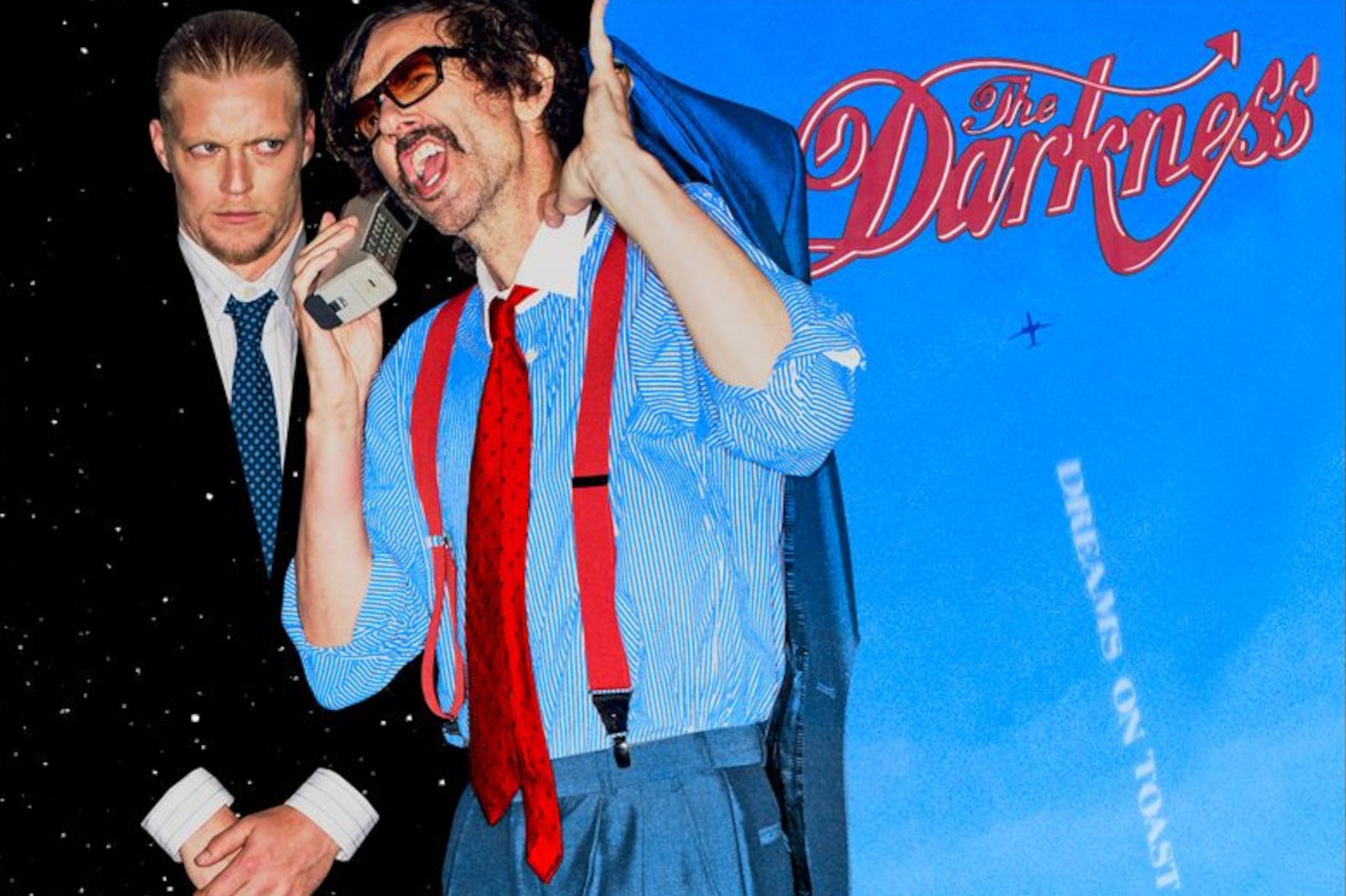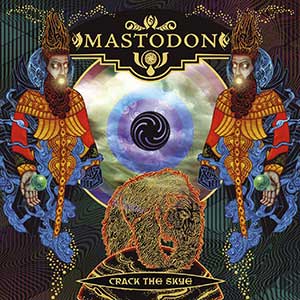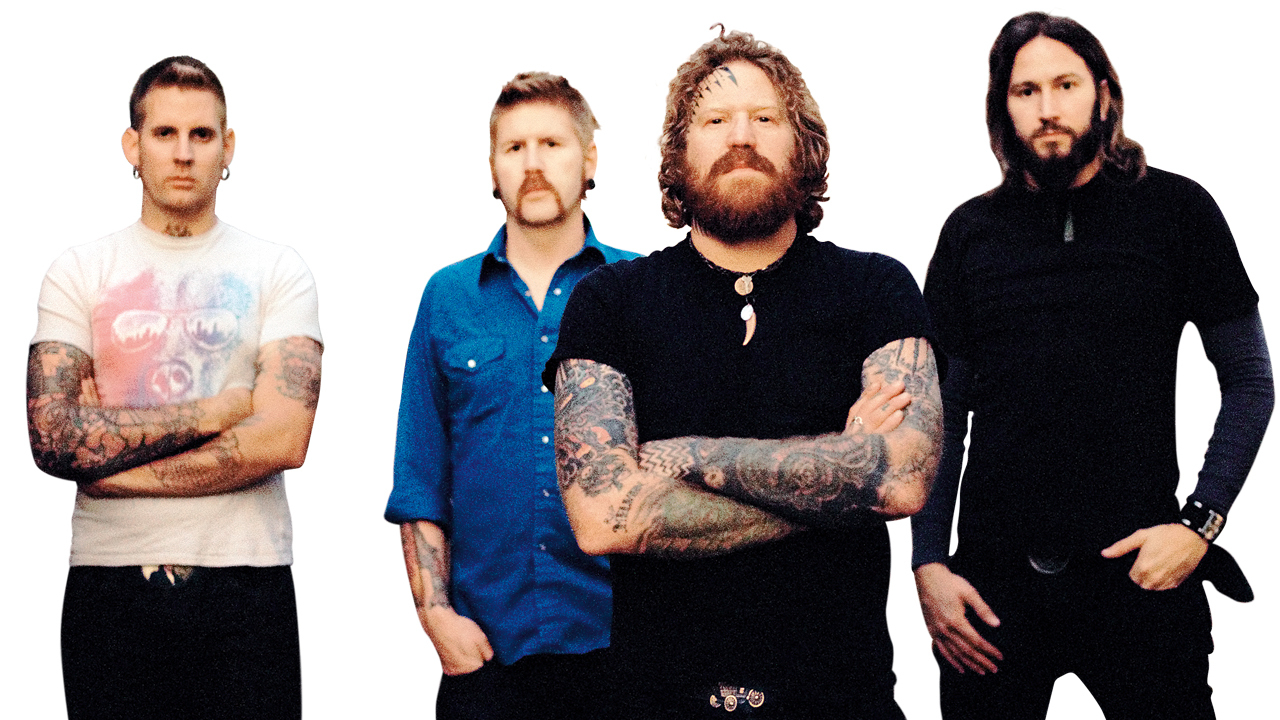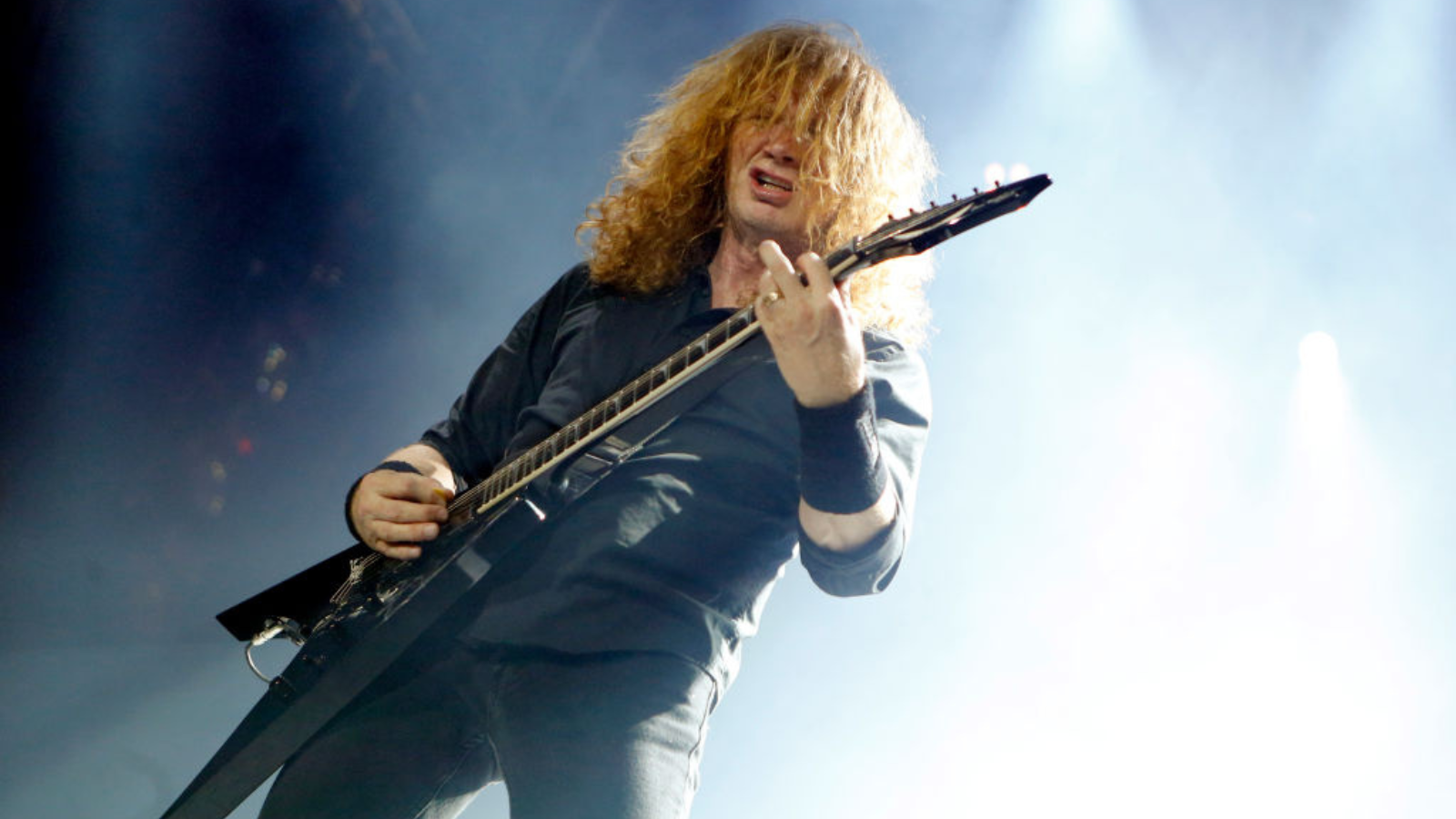From their barnstorming 1978 days as an opening act to their final shows as homecoming rock legends in 2015, Van Halen‘s set lists changed a lot over their touring career.
Here’s a chronological breakdown of the average set lists from each of Van Halen’s 15 major tours, showing which songs were added from the group’s 12 studio albums for each new tour, and which were taken out of rotation.
Of course, Van Halen’s song choices often depending on who was their lead singer at the time of each tour. When Sammy Hagar took over for David Lee Roth in 1986, he was careful to lean more heavily on his own work with the band instead of filling half the show with Roth-era classics.
Upon his return to the group in 2007, Roth drew an even clearer line in the sand, never singing a single Hagar-era song during any of the group’s three final tours. As for Gary Cherone? In his brief time as the group’s frontman he was an equal opportunity singer.
With data from SetList.fm, here’s a look at how Van Halen’s set lists evolved between 1978 and 2015.
It should be noted that each entry below is focused on the average set lists for each tour – sometimes Van Halen would switch things up for a show or two, or for a portion of the tour. It’s also a bit hard to track instrumental songs such as “Eruption” and “Cathedral,” which start out getting their own spot on the set list but were eventually subsumed into Eddie Van Halen‘s nightly guitar solo showcase.
1978 World Tour
After years of honing their performance and songwriting skills on the club scene, Van Halen exploded onto the rock world at large with their self-titled 1978 debut album.
The group capitalized by performing a staggering 174 shows that year, opening for – and often stealing the spotlight from – everybody from Journey to Ted Nugent to the Rolling Stones. Although they understandably focused on material from their first album, they would occasionally sneak in “Somebody Get Me a Doctor,” which wound up on their second album.
Typical 1978 World Tour Set List
1. “On Fire”
2. “I’m the One”
3. Bass Solo
4. “Runnin’ With the Devil”
5. “Atomic Punk”
6. Drum Solo
7. “Little Dreamer”
8. “Feel Your Love Tonight”
9. “Ain’t Talkin’ ’bout Love”
10. Guitar Solo
11. “You Really Got Me” (Kinks cover)
12. “Ice Cream Man” (John Brim cover)
Songs per album:
Van Halen: 9
Read More: How Van Halen Conquered the World With Just 10 Shows
1979 ‘World Vacation’ Tour
Van Halen kept the pedal to the metal in 1979, releasing Van Halen II just thirteen months after their debut, taking advantage of the large backlog of original material they had assembled before signing a record deal.
They were full-time arena headliners already, a change which allowed them to add a heavy dose of songs from the new album while keeping most of the songs from their previous tour, and even adding Van Halen‘s “Jamie’s Cryin'” into permanent rotation.
Typical World Vacation Tour Set List:
(new songs in bold)
1. “Light Up the Sky” (from 1979’s Van Halen II)
2. “Somebody Get Me a Doctor” (from Van Halen II)
3. Drum Solo
4. “Runnin’ With the Devil” (from Van Halen)
5. “Dance the Night Away” (from Van Halen II)
6. “Beautiful Girls” (from Van Halen II)
7. “On Fire” (from Van Halen)
8. Bass Solo
9. “You’re No Good” (Dee Dee Warwick cover, from Van Halen II)
10. “Jamie’s Cryin'” (from Van Halen)
11. “Feel Your Love Tonight” (from Van Halen)
12. “Outta Love Again” (from Van Halen II)
13. “Ice Cream Man” (from Van Halen)
14. “Ain’t Talkin’ ’bout Love” (from Van Halen)
15. Guitar Solo
16. “You Really Got Me” (from Van Halen)
17. “Bottoms Up!” (from Van Halen II)
Songs per album:
Van Halen II: 8
Van Halen: 6
1980 ‘World Invasion’ Tour
Even though 1980’s Women and Children First, was dominated by newly-written material, Van Halen turned it around even faster than they did their second album, releasing their third album just a year and three days after Van Halen II.
New songs such as “Everybody Wants Some!!” and “And the Cradle Will Rock…” were more dynamic and perfectly designed for the arena-sized audiences the band was now drawing.
They hit the road for the 130-date ‘World Invasion’ tour, adding five songs from Women and Children First and a cover of Jimmy Reed’s “Bright Lights, Big City,” while dropping previous tour staples such as Van Halen II‘s “Somebody Get Me a Doctor,” “Beautiful Girls” and “You’re No Good” along with Van Halen‘s “Feel Your Love Tonight.”
Typical ‘World Invasion’ Set List:
1. “Romeo Delight” (from 1980’s Women and Children First)
2. “Bottoms Up!” (from Van Halen II)
3. Drum Solo
4. “Runnin’ With the Devil” (from Van Halen)
5. “Tora! Tora! / Loss of Control” (from Women and Children First)
6. “Take Your Whiskey Home” (from Women and Children First)
7. “Dance the Night Away” (from Van Halen II)
8. “Women in Love…” (from Van Halen II)
9. “Jamie’s Cryin'” (from Van Halen)
10. “Bright Lights, Big City” (Jimmy Reed cover)
11. “Everybody Wants Some!!” (from Women and Children First)
12. “And the Cradle Will Rock…” (from Women and Children First)
13. “On Fire” (from Van Halen)
14. Guitar Solo
15. “Ain’t Talkin’ ’bout Love” (from Van Halen)
16. “Ice Cream Man” (from Van Halen)
17. “You Really Got Me” (from Van Halen)
Songs per album:
Van Halen – 6
Women and Children First – 5
Van Halen II – 3
1981 ‘Fair Warning’ Tour
Van Halen kept up their breakneck recording pace, dropping 1981’s Fair Warning just 13 months after Women and Children First. The dark and aggressive record found Eddie Van Halen asserting himself more in the songwriting process, the first steps in a tug of war that would eventually lead to David Lee Roth leaving the band.
They slowed down on the road just a bit, with 1981 being the first time in four years that the group hadn’t played at least 117 shows. With less pop influence than previous albums, Fair Warning didn’t reach the commercial heights of its predecessors, but tracks like “Mean Street” and particularly “Unchained” became fan favorites almost overnight.
Van Halen‘s “On Fire” returned to its early days show-opening spot, with “Ain’t Talkin’ ’bout Love” took over closing duties, and “Feel Your Love Tonight” returned to the set. To make way for a half-dozen Fair Warning songs, “Bottoms Up!,” “Loss of Control,” “Take Your Whiskey Home,” “Women in Love” and most shockingly, “…And the Cradle Will Rock” were removed from the set lists.
The audio from Van Halen’s June 11th show in Oakland, California was reportedly recorded in full, but has yet to be released. In fact, somehow Van Halen neglected to release a live album during Roth’s first tenure with the group. Video of three songs from the Oakland shows were released by the band and can be seen below.
Typical ‘Fair Warning’ Set List:
1. “On Fire” (from Van Halen)
2. “Sinner’s Swing” (from 1981’s Fair Warning)
3. Drum Solo
4. “Hear About it Later” (from Fair Warning)
5. “So This is Love?” (from Fair Warning)
6. “Jamie’s Cryin'” (from Van Halen)
7. Bass Solo
8. “Runnin’ With the Devil” (from Van Halen)
9. “Dance the Night Away” (from Van Halen II)
10. “Sunday Afternoon in the Park” (from Fair Warning)
11. “Romeo Delight” (from Women and Children First)
12. “Everybody Wants Some!!” (from Women and Children First)
13. “Ice Cream Man” (from Van Halen)
14. “Mean Street” (from Fair Warning)
15. Guitar Solo
16. “Feel Your Love Tonight” (from Van Halen)
17. “You Really Got Me” (from Van Halen)
18. “Unchained” (from Fair Warning)
19. “Ain’t Talkin’ ’bout Love” (from Van Halen)
Songs per album:
Van Halen: 7
Fair Warning: 6
Women and Children First: 2
Van Halen II: 1
1982-83 ‘Hide Your Sheep’ Tour
In need of some time off the road and away from the recording studio, Van Halen agreed to release a stand-alone cover of Roy Orbison’s ‘Oh, Pretty Woman” in return for a break from the grueling schedule of their last four years.
But when the song was an unexpectedly large hit, their label pressured them to get a corresponding album together. They reluctantly did so by cobbling together a bunch of covers, instrumentals and revamping old unreleased songs such as “Hang ‘Em High.” Although Eddie Van Halen was very unhappy about all the covers – consider this a loss for him in that tug of war – Diver Down ended up a surprisingly excellent and cohesive record.
The band hit the road again in July of 1982, staying on the road for just shy of 100 dates this time, including their infamously off-the-rails US Festival performance. A whopping nine songs from Diver Down were added to the set list but that number is a bit deceiving, as “Cathedral,” “Intruder” and their a Capella cover of “Happy Trails” are all very brief.
“Bottoms Up!” also made its way back into the set list, teaming up with the Diver Down songs to push out “On Fire,” “Sinner’s Swing,” Hear About it Later,” “So This is Love?,” “Sunday Afternoon in the Park,” “Mean Street” (leaving “Unchained” as the only Fair Warning song to make it to the next tour) and “Feel Your Love Tonight.”
Typical ‘Hide Your Sheep’ Set List:
1. “Romeo Delight” (from Women and Children First)
2. “Unchained” (from Fair Warning)
3. Drum Solo
4. “Runnin’ With the Devil” (from Van Halen)
5. “The Full Bug” (from 1982’s Diver Down)
6. “Jamie’s Cryin'” (from Van Halen)
7. “Little Guitars” (from Diver Down)
8. “Where Have All the Good Times Gone” (Kinks cover, from Diver Down)
9. Bass Solo
10. “Hang ‘Em High” (from Diver Down)
11. “Cathedral” (from Diver Down)
12. “Secrets” (from Diver Down)
13. “Dance the Night Away” (from Van Halen II)
14. “Everybody Wants Some!!” (from Women and Children First)
15. “Somebody Get Me a Doctor” (from Van Halen II)
16. “Ice Cream Man” (from Van Halen)
17. “Intruder” (from Diver Down)
18. “Oh, Pretty Woman” (Roy Orbison cover, from Diver Down)
19. Guitar Solo
20. “Ain’t Talkin’ ’bout Love” (from Van Halen)
21. “Bottoms Up!” (from Van Halen II)
22. “You Really Got Me” (from Van Halen)
23. “Happy Trails” (Roy Rogers cover, from Diver Down)
Songs per album:
Diver Down: 9
Van Halen: 5
Van Halen II: 3
Women and Children First: 2
Fair Warning: 1
1984 ‘1984’ Tour
Still smarting from being forced to fill Diver Down with cover songs, Eddie Van Halen built a recording studio at his own house and demanded more creative control on the next Van Halen album, 1984. He overcame the objections of David Lee Roth and others in the camp to include two keyboard-heavy singles on the record, and was proven correct when “Jump” became the band’s first and only No. 1 single.
The tour’s typical set list included seven of the nine songs from 1984. To make room, six of the nine Diver Down tracks were removed from the show, leaving just “Cathedral,” “Little Guitars” and “Oh, Pretty Woman.”
Van Halen’s “On Fire” was also brought back, helping to push out longtime staples such as “Dance the Night Away” and “Ice Cream Man.”
Six short years after they exploded onto the worldwide touring scene, the original lineup of Van Halen played their last-ever concert together on Sept. 2, 1984 in Nuremberg, Germany.
Typical ‘1984’ Set List
1. “Unchained” (from Fair Warning)
2. “Hot for Teacher” (from 1984’s 1984)
3. Drum Solo
4. “On Fire” (from Van Halen)
5. “Runnin’ With the Devil” (from Van Halen)
6. “Little Guitars” (from Diver Down)
7. “Cathedral” (from Diver Down)
8. “House of Pain” (from 1984)
9. Bass Solo
10. “Jamie’s Cryin'” (from Van Halen)
11. “I’ll Wait” (from 1984)
12. “Everybody Wants Some!!” (from Women and Children First)
13. “Girl Gone Bad” (from 1984)
14. “1984” (from 1984)
15. “Jump” (from 1984)
16. Guitar Solo
17. “Oh, Pretty Woman” (from Diver Down)
18. “Panama” (from 1984)
19. “You Really Got Me” (from Van Halen)
20. “Ain’t Talkin’ ’bout Love” (from Van Halen)
Songs per album:
1984: 7
Van Halen: 5
Diver Down: 3
Fair Warning: 1
Women and Children First: 1
Van Halen II: 0
1986 ‘5150’ Tour
After shocking the world by splitting up with David Lee Roth at the height of their collective powers, Van Halen turned to Sammy Hagar, fresh off his “I Can’t Drive 55” success and capable of selling out arenas as a solo act, as their new frontman for 1986’s 5150 album.
Determined to carve out a new identity for their new lineup, the group resisted making music videos – which had been a big factor in 1984‘s success – and wiped all but four Roth-era songs from their set lists.
The show instead featured eight of the nine tracks from 5150, two each from Van Halen and 1984, and a pair from Hagar’s solo career: “I Can’t Drive 55” and Standing Hampton‘s “There’s Only One Way to Rock,” during which Hagar gamely engaged in a guitar duel with Eddie Van Halen.
Hagar mostly declined to sing the band’s recent hit single “Jump,” instead bringing up a fan or local celebrity to do the honors. A cover of Led Zeppelin‘s ‘Rock and Roll,” which Hagar and Van Halen played together while announcing their union at Live Aid, typically closed out the show.
This became the first Van Halen tour to be chronicled on home video, as a slightly condensed version of their New Haven, CT show was released as Live Without a Net.
Typical ‘5150’ Tour Set List:
1. “You Really Got Me” (from Van Halen)
2. “There’s Only One Way to Rock” (from Hagar’s Standing Hampton)
3. “Summer Nights” (from 5150)
4. “Get Up” (from 5150)
5. Drum Solo
6. “Dreams” (from 5150)
7. “5150” (from 5150)
8. Bass Solo
9. “Panama” (from 1984)
10. “Best of Both Worlds” (from 5150)
11. “Love Walks In” (from 5150)
12. “Good Enough” (from 5150)
13. Guitar Solo
14. “I Can’t Drive 55” (from Hagar’s VOA)
15. “Ain’t Talkin’ ’bout Love” (from Van Halen)
16. “Why Can’t This Be Love” (from 5150)
17. “Jump” (from 1984)
18. “Rock and Roll” (Led Zeppelin cover)
Songs per album:
5150 – 8
1984 – 2
Van Halen – 2
VOA – 1
Standing Hampton – 1
1988-1989 ‘OU812’ Tour
After a brief break to allow Sammy Hagar to record the contractually-mandated farewell solo album I Never Said Goodbye for his former label (with help from Eddie Van Halen on bass) Van Halen got to work on what might be their most diverse album ever.
1988’s OU812 saw the band dive even deeper into keyboard pop, as well as pushing their boundaries in other ways, such as the country-tinged “Finish What Ya Started” and the prog / jazz / fusion influenced “Mine All Mine.”
The group stretched out their set lists a bit longer than on the 5150 tour, keeping four songs from 5150 to go along with six from OU812, adding “Runnin’ With the Devil” from the Roth Years and “When Eagles Fly” from Hagar’s latest solo album. “Jump” also vanished from the set lists.
This would also be the last time Eddie Van Halen played live keyboards on stage. For their next four tours they hired Alan Fitzgerald of Montrose and Night Ranger fame to perform the keyboard parts off stage, and in 2004 they switched to using pre-recorded tapes of Eddie Van Halen’s playing.
The band’s Feb. 1, 1989 show in Tokyo was pro-shot and is widely available on the internet.
Typical ‘OU812’ Tour Set List:
1. “A.F.U. (Naturally Wired)” (from OU812)
2. “There’s Only One Way to Rock” (from Hagar’s Standing Hampton)
3. “Summer Nights” (from 5150)
4. “Panama” (from 1984)
5. Bass Solo
6. “Runnin’ With the Devil” (from Van Halen)
7. “Why Can’t This Be Love” (from 5150)
8. “Mine All Mine” (from OU812)
9. Drum Solo
10. “Finish What Ya Started” (from OU812)
11. “5150” (from 5150)
12. “Cabo Wabo” (from OU812)
13. “When It’s Love” (from OU812)
14. “Eagles Fly” (From 1987’s I Never Said Goodbye by Sammy Hagar)
15. “I Can’t Drive 55” (from Hagar’s VOA)
16. “Best of Both Worlds” (from 5150)
17. Guitar Solo
18. “Black and Blue” (from OU812)
19. “Ain’t Talkin’ ’bout Love” (from Van Halen)
20. “You Really Got Me” (from Van Halen)
21. “Rock and Roll” (Led Zeppelin cover)
Songs per album:
OU812 – 6
5150 – 4
Van Halen – 3
1984 – 2
VOA – 1
Standing Hampton – 1
I Never Said Goodbye – 1
1991-1992 ‘For Unlawful Carnal Knowledge’ Tour
After three increasingly diverse and pop-friendly albums, Van Halen made a return to straight-ahead guitar-based hard rock on 1991’s charmingly titled For Unlawful Carnal Knowledge.
Only the surprise hit single “Right Now” – which used a traditional piano, not keyboards – strayed from this wall of guitars formula. The group’s live show changed accordingly, with keyboards relegated to an off-stage role.
Over 20 years into their worldwide touring career, Van Halen was still anything but a nostalgia act, as they put six songs from their new album into the set, cutting back a couple each from 5150 and OU812. Otherwise, the set followed the same basic shape as their previous two tours with Hagar – three of his solo songs, three from the Roth days.
This was the first Van Halen tour to be chronicled on an honest-to-goodness live album, the 1993 double-record set Live: Right Here Right Now. A full-length home video companion was also released.
The live album featured a whopping 24 tracks, including all but one F.U.C.K. song and a cover of the Who‘s “Won’t Get Fooled Again.”
Typical ‘For Unlawful Carnal Knowledge’ Tour Set List:
1. “Poundcake” (from 1991’s For Unlawful Carnal Knowledge)
2. “Judgement Day” (from 1991’s For Unlawful Carnal Knowledge)
3. “Runaround” (from 1991’s For Unlawful Carnal Knowledge)
4. “When It’s Love” (from OU812)
5. “There’s Only One Way to Rock” (from Hagar’s Standing Hampton)
6. Bass Solo
7. “Pleasure Dome” (instrumental) (from 1991’s For Unlawful Carnal Knowledge)
8. Drum Solo
9. “A.F.U. (Naturally Wired)” (from OU812)
10. “Panama” (from 1984)
11. “Why Can’t This Be Love” (from 5150)
12. “Finish What You Started” (from OU812)
13. “Eagles Fly” (from Hagar’s I Never Said Goodbye)
14. Guitar Solo
15. “You Really Got Me” (from Van Halen)
16. “I Can’t Drive 55” (from VOA)
17. “Best of Both Worlds” (from 5150)
18. “The Dream is Over” (from 1991’s For Unlawful Carnal Knowledge)
19. “Jump” (from 1984)
20. “Top of the World” (from 1991’s For Unlawful Carnal Knowledge)
Songs per album:
For Unlawful Carnal Knowledge – 6
OU812 – 3
5150 – 2
1984 – 2
Van Halen – 1
VOA – 1
Standing Hampton – 1
1993 ‘Right Here Right Now’ Tour
On their first-ever tour in support of a live album instead of a new studio effort, Van Halen didn’t have any new material to freshen up the set list.
So they switched things around using their back catalog, bringing back songs that had dropped from the show in recent years and giving “Right Now” (which was only played 35 times on their last tour) a full-time slot.
Hagar’s “I Can’t Drive 55” and “Eagles Fly” were dropped from the set list in favor of another I Never Said Goodbye song, “Give to Live.” He also went deeper into the Roth-era catalog by singing both “Jump” and “Unchained.” Most nights the group closed out the show with a cover of Neil Young‘s instant classic “Rockin’ in the Free World.”
Typical ‘Right Here Right Now’ Set List:
1. “Mine All Mine” (from OU812)
2. “Poundcake” (from For Unlawful Carnal Knowledge)
3. Judgement Day” (from For Unlawful Carnal Knowledge)
4. “Why Can’t This Be Love” (from 5150)
5. “Runaround” (from For Unlawful Carnal Knowledge)
6. “Panama” (from 1984)
7. Bass Solo
8. “Pleasure Dome” (instrumental) (from For Unlawful Carnal Knowledge)
9. Drum Solo
10. “Dreams” (from 5150)
11. “Right Now” (from For Unlawful Carnal Knowledge)
12. “Finish What You Started” (from OU812)
13. “Top of the World” (from For Unlawful Carnal Knowledge)
14. “Give to Live” (from Hagar’s I Never Said Goodbye)
15. “Best of Both Worlds” (from 5150)
16. “Eagles Fly” (from Hagar’s I Never Said Goodbye)
17. “There’s Only One Way to Rock” (from Hagar’s Standing Hampton)
18. Guitar Solo
19. “Unchained” (from Fair Warning)
20. “Ain’t Talkin’ ’bout Love” (from Van Halen)
21. “Jump” (from 1984)
22. “You Really Got Me” (from Van Halen)
23. “Rockin’ in the Free World” (Neil Young cover)
Songs per album:
For Unlawful Carnal Knowledge – 6
OU812 – 2
5150 – 3
1984 – 2
Van Halen – 1
Fair Warning – 1
I Never Said Goodbye – 1
Standing Hampton – 1
1995 ‘Balance’ Tour
Van Halen ran into stormy seas on their fourth and final studio album with Sammy Hagar. Personality conflicts and the arrival of grunge weighed heavily on the disjointed Balance, which nonetheless roared to the top of the charts.
With Eddie Van Halen dealing with a hip injury and his drumming brother Alex in a neck brace, the group’s shows in support of the album became known as the “ambulance tour.”
There was more variety in the set lists than on previous tours. Although it’s not listed in the average set list below, “There’s Only One Way to Rock” was played at about two-thirds of the show, and Balance‘s lead single “Don’t Tell Me (What Love Can Do)” was played at about half. (You can see the full tour stats here.)
As had become tradition, six songs from the new Balance album worked their way into the set list, edging out everything from OU812 and all but the biggest hit singles from 5150.
Two August 1995 shows from Toronto were filmed and released via Pay-Per-View in December of that same year, although the show has yet to be made legally available on home video yet.
Typical ‘Balance’ Tour Set List:
1. “The Seventh Seal” (from 1995’s Balance)
2. “Big Fat Money” (from Balance)
3. “Runaround” (from For Unlawful Carnal Knowledge)
4. “Top of the World” (from For Unlawful Carnal Knowledge)
5. “Amsterdam” (from Balance)
6. Bass Solo
7. “Aftershock” (from Balance)
8. “Why Can’t This Be Love” (from 5150)
9. Drum Solo
10. “Can’t Stop Lovin’ You” (from Balance)
11. “Feelin'” (from Balance)
12. “Ain’t Talkin’ ’bout Love” (from Van Halen)
13. “Right Now” (from For Unlawful Carnal Knowledge)
14. “You Really Got Me” (from Van Halen)
15. “Eagles Fly” (from Hagar’s I Never Said Goodbye)
16. Guitar Solo
17. “Jump” (from 1984)
18. “Dreams” (from 5150)
19. “Panama” (from 1984)
Songs per album:
Balance – 6
For Unlawful Carnal Knowledge – 3
5150 – 2
Van Halen – 2
1984 – 2
I Never Said Goodbye – 1
OU812 – 0
1998 ‘III’ Tour
For the second (but certainly not last) time in their career, Van Halen parted ways with another lead singer after the Balance tour, replacing Hagar with longtime Extreme vocalist Gary Cherone on 1998’s much-maligned III.
However you feel about that record, Cherone’s arrival gave Van Halen a singer who was eager to tackle songs from both previous eras of the band’s career. So in addition to the five songs they played from III on an average night, the group also dug out long-lost Roth-era gems such as “Mean Street” and “Dance the Night Away.”
The biggest hits of the Hagar years were also included. In a odd footnote, Cherone not Hagar became the first to sing “Humans Being” from the Twister soundtrack live with the group, since it came out after the Balance tour.
Michael Anthony also got a new way to shine on this tour, replacing his normal bass solo spotlight by taking lead vocals for Van Halen II‘s “Somebody Get Me a Doctor.”
The band’s April 20th show in Sydney Australia was professionally filmed and aired live on MTV. So if there’s ever a Van Halen III box set, maybe that will be included.
Cherone was dismissed from the band after a brief attempt to record a second album together, and none of the III songs have ever graced a Van Halen set list again.
Typical ‘III’ Tour Set List
1. “Unchained” (from Fair Warning)
2. “Without You” (From 1998’s Van Halen III)
3. “One I Want” (From 1998’s Van Halen III)
4. “Mean Street” (from Fair Warning)
5. “When It’s Love” (from OU812)
6. “Fire in the Hole” (From 1998’s Van Halen III)
7. “Why Can’t This Be Love” (from 5150)
8. “Romeo Delight” (from Women and Children First)
9. Drum Solo
10. “Dance the Night Away” (From Van Halen II)
11. “Humans Being” (from the Twister soundtrack)
12. “Somebody Get Me a Doctor” (from Van Halen II)
13. “Year to the Day” (From 1998’s Van Halen III)
14. Guitar Solo
15. “Right Now” (from For Unlawful Carnal Knowledge)
16. “Ain’t Talkin’ ’bout Love” (from Van Halen)
17. “Josephina” (From 1998’s Van Halen III)
18. “Panama” (from 1984)
19. “Jump” (from 1984)
Songs per album:
Van Halen III: 5
1984: 2
Fair Warning: 2
Van Halen II: 2
Women and Children First: 1
For Unlawful Carnal Knowledge: 1
OU812: 1
5150: 1
Van Halen: 1
Twister Soundtrack: 1
Summer 2004 Tour
Did you ever get back together with your ex and then quickly remember why you broke up? That seems to be what happened on Van Halen’s summer 2004 tour, as Hagar returned to a tour that was plagued by personal disputes and Van Halen’s substance abuse battle.
The tour featured the heaviest dose of Roth-era Van Halen of any Hagar-fronted tour, with the once-banished “Jump” now serving as each night’s opening track. Anthony stayed on his “Doctor” duties, while most of Hagar’s solo songs were performed during his nightly solo acoustic segment – no more guitar duels.
Oh yeah and they also played all three songs from the new The Best of Both Worlds compilation album, which frankly are best forgotten.
After the tour-closing Nov. 19, 2004 marked several important (and somewhat sad) milestones. It was the last time Hagar would ever sing with the group, the last time they performed any songs from his era live and also the last time bassist Michael Anthony would ever play live with the band.
Typical Summer 2004 Set List
1. “Jump” (from 1984)
2. “Runaround” (from For Unlawful Carnal Knowledge)
3. “Humans Being” (from Twister Soundtrack)
4. “Up for Breakfast” (from The Best of Both Worlds)
5. Bass Solo
6. “Somebody Get Me a Doctor” (from Van Halen II)
7. “Poundcake” (from For Unlawful Carnal Knowledge)
8. “It’s About Time” (from The Best of Both Worlds)
9. Drum Solo
10. “Top of the World” (from For Unlawful Carnal Knowledge)
11. “Unchained” (from Fair Warning)
12. “Why Can’t This Be Love” (from 5150)
13. “Eagles Fly” (from Hagar’s I Never Said Goodbye)
14. “Deeper Kinda Love” (from Hagar’s Ten 13)
15. “The Seventh Seal” (from Balance)
16. “Best of Both Worlds” (from 5150)
17. Guitar Solo
18. “Dreams” (from 5150)
19. “Ain’t Talkin’ ’bout Love” (from Van Halen)
20. “Right Now” (from For Unlawful Carnal Knowledge)
21. You Really Got Me” (from Van Halen)
22. “Panama” (from 1984)
23. “When It’s Love” (from OU812)
Songs per album:
For Unlawful Carnal Knowledge – 4
The Best of Both Worlds – 3
5150 – 3
Van Halen – 2
1984 – 2
I Never Said Goodbye – 1
Ten 13 – 1
Van Halen II – 1
OU812 – 1
Fair Warning – 1
Twister Soundtrack: 1
Balance – 1
2007-2008 North American Tour
After 27 years apart, Van Halen reunited with original frontman David Lee Roth for a long-awaited and much-rumored reunion tour.
It seems Eddie Van Halen’s primary motivation for this tour was the chance to play live with his son Wolfgang, who took over for Michael Anthony on bass. (There was also some animosity over Anthony joining Hagar’s tours during Van Halen’s long stretches of inactivity.)
The foursome didn’t record a new album prior to the tour, but that hardly mattered as they had six classic album’s worth of songs, many of which hadn’t been performed live since Roth’s departure.
The group played at least two songs from each of their Roth-era album, paying extra attention their their 1978 debut, which dominated the proceedings with eight tracks (plus “Eruption,” which had long ago switched from being listed separately on the set lists to being the basis of Eddie’s nightly guitar solos.)
Obviously all trace of the Hagar years was erased, and Wolfgang had no interest in performing a bass solo, leaving extra room for his father and uncle to show off their individual talents.
Typical 2007-2008 Set List:
1. “You Really Got Me” (from Van Halen)
2. “I’m the One” (from Van Halen)
3. “Runnin’ With the Devil” (from Van Halen)
4. “Romeo Delight” (from Women and Children First)
5. “Somebody Get Me a Doctor” (from Van Halen II)
6. “Beautiful Girls” (from Van Halen II)
7. “Dance the Night Away” (from Van Halen II)
8. “Atomic Punk” (from Van Halen)
9. “Everybody Wants Some!!” (from Women and Children First)
10. “So This is Love?” (from Fair Warning)
11. “Mean Street” (from Fair Warning)
12. “Oh, Pretty Woman” (from Diver Down)
13. Drum Solo
14. “Unchained” (from Fair Warning)
15. “I’ll Wait” (from 1984)
16. “And the Cradle Will Rock…” (from Women and Children First)
17. “Hot for Teacher” (from 1984)
18. “Little Dreamer” (from Van Halen)
19. “Little Guitars” (from Diver Down)
20. “Jamie’s Cryin'” (from Van Halen)
21. “Ice Cream Man” (from Van Halen)
22. “Panama” (from 1984)
23. Guitar Solo
24. “Ain’t Talkin’ ’bout Love” (from Van Halen)
25. “1984” (from 1984)
26. “Jump” (from 1984)
Songs per album:
Van Halen: 8
1984: 5
Fair Warning: 3
Women and Children First: 3
Van Halen II: 3
Diver Down: 2
2012-2013 ‘A Different Kind of Truth’ Tour
Want to hear a wild stat? Van Halen’s 2012-2013 tour marked the first time in 18 years that Van Halen began a tour with the same singer who had performed on their last tour.
This time out they were promoting their first new studio album in 14 years, and the first to feature Roth in 28 years. Four songs from A Different Kind of Truth made it into the set list, including “She’s the Woman,” a reworked track from the band’s earliest days.
The rest of the show featured the most even distribution of tracks from each of the group’s first six albums ever, with 1984 and Van Halen getting four and every other album except Diver Down getting at least two.
This was also finally, finally the first Roth-era Van Halen tour to be represented with a live album, although Tokyo Dome: Live in Concert doesn’t seem to live up to the excitement and excellence most of us heard on that tour.
Typical ‘A Different Kind of Truth’ Tour Set List:
1. “Unchained” (from Fair Warning)
2. “Runnin’ With the Devil” (from Van Halen)
3. “She’s the Woman” (from 2012’s A Different Kind of Truth)
4. “Tattoo” (from 2012’s A Different Kind of Truth)
5. “Romeo Delight” (from Women and Children First)
6. “Everybody Wants Some!!” (from Women and Children First)
7. “Somebody Get Me a Doctor” (from Van Halen II)
8. “China Town” (from 2012’s A Different Kind of Truth)
9. “Hear About it Later” (from Fair Warning)
10. “Oh, Pretty Woman” (from Diver Down)
11. “You Really Got Me” (from Van Halen)
12. Drum Solo
13. “The Trouble With Never” (from 2012’s A Different Kind of Truth)
14. “Dance the Night Away” (from Van Halen II)
15. “I’ll Wait” (from 1984)
16. “And the Cradle Will Rock…” (from Women and Children First)
17. “Hot for Teacher” (from 1984)
18. “Women in Love…” (from Van Halen II)
19. “Beautiful Girls” (from Van Halen II)
20. “Ice Cream Man” (from Van Halen)
21. “Panama” (from 1984)
22. Guitar Solo
23. “Ain’t Talkin’ ’bout Love” (from Van Halen)
24. “Jump” (from 1984)
Songs per album:
1984: 4
Van Halen: 4
Van Halen II: 4
A Different Kind of Truth: 4
Women and Children First: 3
Fair Warning: 2
Diver Down: 1
Van Halen 2015 North American Tour
Van Halen dug deep into their catalog for their third straight tour with Roth, adding a half-dozen rarely or even never-played songs into their nightly set lists. This including using Van Halen II’s “Light Up the Sky” as an opener, while also breaking out 1984‘s “Drop Dead Legs,” Diver Down‘s “Little Guitars” and Fair Warning‘s “Dirty Movies.”
The tour concluded with two October 2015 shows at the Hollywood Bowl in the band’s hometown of Los Angeles. During the first of them Roth paid an impromptu onstage tribute to Eddie Van Halen, telling him, “The best years of my life; the high points of all my life – onstage with you, homeboy.”
It turned out to be a farewell. While the band had been discussing a “kitchen sink” tour featuring Roth, Hagar and Cherone all together, Eddie Van Halen began battling a series of serious health issues in 2019 and died on October 6, 2020, bringing an end to his namesake band and one of the most impressive touring careers in rock history.
Typical Van Halen 2015 North American Tour Set List:
1. “Light Up the Sky” (from Van Halen II)
2. “Runnin’ With the Devil” (from Van Halen)
3. “Romeo Delight” (from Women and Children First)
4. “Everybody Wants Some!!” (from Women and Children First)
5. “Drop Dead Legs” (from 1984)
6. “Feel Your Love Tonight” (from Van Halen)
7. “Somebody Get Me a Doctor” (from Van Halen II)
8. “She’s the Woman” (from 2012’s A Different Kind of Truth)
9. “China Town” (from 2012’s A Different Kind of Truth)
10. “I’ll Wait” (from 1984)
11. Drum Solo
12. “Little Guitars” (from Diver Down)
13. “Dance the Night Away” (from Van Halen II)
14. “Beautiful Girls” (from Van Halen II)
15. “Women in Love…” (from Van Halen II)
16. “Hot for Teacher” (from 1984)
17. “In a Simple Rhyme” (from Women and Children First)
18. “Dirty Movies” (from Fair Warning)
19. “Ice Cream Man” (from Van Halen)
20. “Unchained” (from Fair Warning)
21. “Ain’t Talkin’ ’bout Love” (from Van Halen)
22. Guitar Solo
23. “You Really Got Me” (from Van Halen)
24. “Panama” (from 1984)
25. “Jump” (from 1984)
Songs per album:
1984: 5
Van Halen II: 5
Van Halen: 5
Women and Children First: 3
Fair Warning: 2
A Different Kind of Truth: 2
Diver Down: 1
Van Halen Albums Ranked
A ranking of every Van Halen album.
Gallery Credit: Ultimate Classic Rock Staff

















![Disclaimer (20th Anniversary Edition)[Deluxe 2 CD]](https://m.media-amazon.com/images/I/51CKxaomB9L._SL500_.jpg)
![DISCLAIMER II [Explicit]](https://m.media-amazon.com/images/I/51zY2ZMKdCL._SL500_.jpg)



![Isolate and Medicate [Deluxe Edition]](https://m.media-amazon.com/images/I/61aRGARycVL._SL500_.jpg)
![Poison The Parish [Deluxe Edition]](https://m.media-amazon.com/images/I/51EBirryiqL._SL500_.jpg)
![Si Vis Pacem, Para Bellum[Deluxe 2 CD]](https://m.media-amazon.com/images/I/41aJ4rE0yIL._SL500_.jpg)
